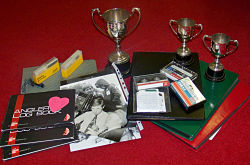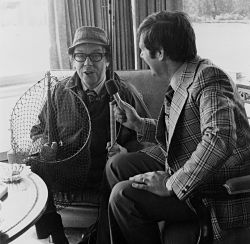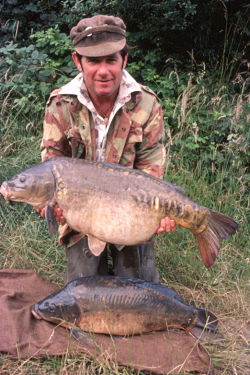

Most anglers with a keen interest in history will know about the Carp Catcher’s Club and Richard Walker’s exploits in capturing the record carp Clarissa, and also how their approach led to modern day specimen angling. However, few people know about the next generation, men such as Gerry Savage, who built on this work and greatly increased the knowledge and also the likelihood of catching these rare and elusive fish in the days before they all had names. The kind donation to Angling Heritage by his family of a wealth of his ephemera and articles aroused much interest, especially seeing a photograph of Gerry in snow and ice, holding a carp. This was very unusual for that period and worthy of further investigation.

Gerry was well known in the South East through his regular fishing programme, Good Fishing on Radio Medway which was subsequently broadcast on Radio London. He also wrote a weekly column in The Dartford Reporter and later became a regular contributor to Angler’s Mail.
Gerry was a keen angler although his first love was carp fishing. He got the bug watching a huge carp (in retrospect he wrote it was probably only around four or five pounds) cruising through a shoal of rudd while walking around a lake at Stone. As his skills improved he caught more and more leading to his exploits in catching 100 in a season (when they had close season on still waters too) and was featured in most of the angling press at the time. His lateral thinking on baits that could be used was demonstrated by his trials with sausage which he kept secret by keeping them from view in a Thermos flask. However, when walking around the lake, he saw a carp take a dead roach and developed cat food as a bait which also proved successful. He later reported his experiences with meat and sardine paste, and the bait presentation in Angler’s Mail
However, reading an article by Jim Gibbinson about catching carp outside of the summer months fired Gerry’s imagination, wondering if they could be caught in winter. Gerry was by now a member of the Dartford Specimen Group and asked if anybody else would like to join him in his quest. Sadly, nobody did, but then a chance meeting led to a partnership which changed the face of carp fishing thereafter.
On October 14th 1967, Gerry met a kindred spirit who was also very keen to experiment and after several discussions found their carp fishing goals were very closely aligned. That person was Fred Wilton, now regarded as the founder of modern day boillie fishing.

Gerry had a wealth of carp fishing expertise having caught over 500 carp to 26.5lb and catch records on waters such as Sutton-at-Hone. Fred Wilton had been developing baits and so the results of the winter fishing experiment could be readily compared to conventional techniques using Gerry’s data. So by the end of October, the two anglers decided to fish through the winter for carp (It was agreed for this purpose, winter started on 1st November).
They decided to target Sutton as their prime water for reasons including:-
a) It had a good head of silver bream which would compete for the little natural food present in the winter, so the chances of encouraging a carp to take would be enhanced over deeper waters with few fish. This would accelerate their results and therefore, learning.
b) The lake was only 8 feet deep so it would be easier to record the temperature the fish were actually experiencing as variations with depth can make a marked difference.
c) Gerry’s knowledge of the water.

Their first excursion was on 5th November when the water temperature was 47º F. The day proved successful with Fred catching a 10lb 4oz fish and Gerry catching two of 6.5lb and 7lb 12oz, a catch worthy of note.
The bait initially devised by Fred was 31% protein with a superb vitamin B profile; vitamins A & D added through the eggs used to mix the bait. The protein levels were later increased to 47% which resulted in improved catches.
They quickly found that as the temperature dropped, the bites became more finicky and that the bait size should be reduced. Large baits generally got knocks, not positive takes. Fred took a little persuading to change bait size due to his dislike of bream, but the returns proved that in winter, small baits worked better for the carp. They also discovered that the carp group more tightly in winter than in summer. Several areas in winter were devoid of carp and this wasn’t always linked to the depth. Some groups were found in just over 18” of water.
One other thing they also discovered was the need to wear good winter clothing. It seems only a few years ago but there were no good clothes for anglers in that period. Wellingtons and Donkey Jackets were widely used across the country. Fred and Gerry found it necessary to use waders two sizes too big with thick socks and warm winter moccasins to keep their feet warm. Fred, being around 6’6” used to have trouble finding footwear large enough, and in one article Gerry asks for help in finding some.
* However, the fact that they could catch carp in very cold conditions made headlines in a trip on 9th December. Snow had fallen and one lake was totally frozen over, and on the second lake, only a small patch was clear of ice which was about 15-20 foot from the bank. Fred had traveeled down form London and was determined to wet a line if possible so fetched a "docker's hook" from his car, tied on a rope and threw it out into the clear water, pulling it back through the ice. fred repeated this until a channel was clear large enough for one rod each. The water temperature was a mere 33.5 º F. Casting out with a 0.75oz Arlesey bomb using a size 6 hook with a bait just large enough to conceal it, Gerry had a spasmodic run that gradually lifted his indicator until it reached the butt ring. Gerry struck into a carp, and after playing it with his rod tip below the surface to prevent line damage caused by the ice, he eventually landed a fish of 7lb 4oz. This was the fish that I had seen in the photograph.
From then on until the end of the season, the pair continued to bag carp catching 72 in the winter of which 13 were double figure, the best being 14lb’ers, one for each angler. This formed part of an amazing season haul with a combined total of 224 carp, 50 being double figure. This was widely reported in the angling press.
Sadly this partnership didn’t last long and although Gerry put the catch down to Fred’s work with high protein baits, and Fred acknowledging that he couldn’t have done it without Gerry’s angling nous the partnership ended acrimoniously. Gerry was keen to make public the information they had learned on baits and published it. Fred had always wanted it to remain secret as he further developed the bait against a known reference. This meant that everyone would change baits to the one they used, which was now widely publicised, and make future evaluation impossible to compare.
As a footnote, whilst I write this article in the shop (I’m meant to be working!!) a customer has just walked in and told me he purchased a Davenport and Fordham Farstrike rod manufactured in Poole Quay bearing Gerry’s Name. He says it was 7.75 oz and he still uses it for freelining carp baits, and added he has caught most of his carp on it over the years as he hasn’t found a better rod for that purpose since, some 40 years later!
Keith Armishaw
Angling Heritage
July 2011
* Much of this paragraph was added correcting some of the detail courtesy of a letter by Fred Wilton in reply to the article which appeared in Classic Angling. We are very grateful for this contribution.